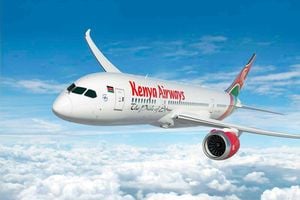WPL Zonal format is the way to go
What you need to know:
- For the 2020 season, the league is back to the zonal format and the arrangement has spurred mixed reactions from various stakeholders.
- Majority of the teams are struggling financially and feel that it is a good decision, while the teams with sponsorships feel that the move is retrogressive.
There is a belief that the state of women football in Kenya has been dire since time immemorial. That the women's game is just a pass time activity that no one really seems to do anything to uplift.
But just like all uneducated guesses, there is the other side to the story. What most people do not know is that the Kenya Women Premier League (KWPL) has had its share of good moments - though short-lived.
In the 2011 and 2012 seasons, the top tier league enjoyed sponsorship from Unicef in collaboration with the then Ministry of Youth Affairs and Sports (Moyas).
In the 12-team league, every team received funds to cater for their weekly transport - which was a welcome relief to the teams as some used it for food and accommodation for their away matches.
Any ardent women's football fan will remember that during that period, teams like Kisii United, Moyas FC, Old is Gold and Western Commandos just to mention but a few sent shockwaves in their opponents' camps with their swashbuckling displays.
DISBANDED
Sadly, all these teams were disbanded almost immediately after Unicef ended its sponsorship with the WPL. This is mainly because the teams could not continue taking part in the league; that now had an increased number of teams and no sponsors, without the aid they had gotten used to for two seasons.
Shortly before the sponsorship was brought to a screeching halt, Football Kenya Federation increased the number of participating teams from 12 to16. It was around the same time that the National Youth Talent Academy (NYTA) students – also sponsored by Unicef - were graduating from their Karen base, in a colourful event held at Safari Park Hotel.
As the men’s team transited into FC Talanta, the women’s side that had just won the league, playing for Matuu Ladies FC, was dissolved and none of the talented ladies had an exit strategy. What a tragedy!
As teams prepared for the 16-team league to kick off amid a cloud of uncertainty, it was obvious that with the financial status of the teams, a different plan had to be hatched.
FKF then resorted to playing the league in what most stakeholders referred to as a "tournament format." Teams would converge on different venues in a rotational format and play their matches over the weekend, before taking a break for say two to three weeks. Was the system effective? One would argue that it was not but it served its purpose and saw the league remain unified, though amidst all the efforts to keep teams playing some could not keep up with the new format hence had to ship out.
Later on, the league was split into two zones, Zone A and B, in order to ease the financial burden on the teams, since most of the teams would manage travelling shorter distances despite the fact that they were playing fewer matches unlike before.
The drawback from this arrangement was that as Zone A enjoyed media coverage and the advantage of having national team coaches attend their matches, more often due to their regional advantage, teams in the other zone felt that they were somehow not given enough attention.
FIFA GRANTS
In 2018, FKF then announced that the league will be unified in order to raise the level of competition. This was also viewed as an avenue for improving players’ match fitness due to the increased number of matches, which would not only benefit the clubs but also the national teams.
The catalyst for having a 16-team league was an annual grant of Sh750,000 that each team would receive, to enable them cover some of their costs.
This was clearly not going to be enough especially for community clubs like Makolanders Ladies FC, that rely heavily on well-wishers.
It was noted that even with the grants, teams still failed to honour matches and as a result Mombasa Olympic, Nyamira Starlets, Vihiga Leeds and Nyuki Starlets were relegated from the WPL after failing to raise funds to honour matches.
Spedag FC, a team that at some point in 2016 had 10 players in the Harambee Starlets squad, has had a rough patch in equal measure and it is not clear whether or not they will even take part in the National Division One league following last season’s relegation.
For the 2020 season, the league is back to the zonal format and the arrangement has spurred mixed reactions from various stakeholders. Majority of the teams are struggling financially and feel that it is a good decision, while the teams with sponsorships feel that the move is retrogressive.
Let’s face it; the WPL is better off in zones for now if we want to save teams that have been doing the amazing job of developing talents. It will be detrimental to have a unified league now that no team is receiving the Fifa grants, while majority are either self-sponsored or rely heavily on well-wishers; which may not be able to sustain the team in the long run.
Playing in zones will mean that the number of matches will reduce from 30 to 14, but teams can always be creative and organise friendly matches or mini tournaments to fill in the gaps and ensure that players’ fitness is not compromised. Until a financial breakthrough that will breathe life into the WPL is realised, let us stick to a manageable plan.
If the sole advantage of playing in a unified league is playing more matches, FKF has the powers to increase the number of teams that participate in the different zones.
The players, who are the most vital cog in this league, must strive to reach their peak as with the recent developments which have seen a couple of players make moves abroad, they never know where they will end up. The zonal format might seen like a drawback, but better days lie ahead.
For as American Civil Rights Movement leader Martin Luther King said: "We must accept finite disappointment, but we must never lose infinite hope."




